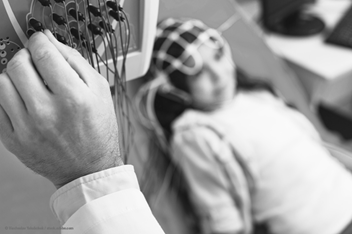Stereoelectroencephalography (SEEG) for Epilepsy
What Is Stereoelectroencephalography (SEEG)?
Stereoelectroencephalography (SEEG) is a test used to find areas where seizures begin in the brain. During this test, your child will undergo surgery. A neurosurgeon will place electrodes deep into the brain through small holes made into the skull. These electrodes are anchored to the skull or skin. After placing the electrodes, your child will have EEG monitoring with video recording to see their brain activity before, during, and after seizures. The epilepsy team will also use these electrodes to stimulate areas of the brain. SEEG monitoring requires a hospital stay, which can last a few days to a few weeks. Once the epilepsy team has the information they need, the neurosurgeon will remove the electrodes and your child can go home.Who Is an SEEG Candidate?
Every child’s epilepsy surgery journey is unique. Some children may need testing using SEEG and some will not. The epilepsy team will review your child’s medical history, medical imaging, and other tests at a surgical conference. The team might recommend SEEG if:- Your child has seizures that have not responded well to anti-seizure medications.
- Your child can’t tolerate anti-seizure medications due to side effects.
- The location(s) of their seizures can’t be clearly identified with other tests.
What Are the Benefits of SEEG?
Intracranial monitoring with SEEG gives the epilepsy team more information about your child’s seizures. It may find an area of the brain where your child’s seizures begin that was not clear from other tests. Because the electrodes are placed at different depths in the brain, SEEG can better pinpoint the exact area(s) where seizures begin. Electrical stimulation with SEEG can help the team identify areas of the brain that are important for certain functions. This information is helpful for making treatment decisions that target the seizures while protecting your child’s language and motor skills.What Are the Risks of SEEG?
The surgery to place the SEEG electrodes uses tools and techniques to maximize safety. Despite this, there are still some risks, including:- Skin or brain infections.
- Stroke or brain bleeding during insertion or removal of electrodes.
Sometimes, electrodes may break, requiring further surgery. The team may also need to implant additional electrodes. It is also possible that the team is still unable to identify the brain area where seizures start after SEEG.

What Happens During SEEG?
Before surgery, the epilepsy team will decide where to place the electrodes using your child’s brain MRI and CT scans. After your child is under general anesthesia, they will be attached to a robot system using a rigid head holder. The neurosurgeon will attach markers to your child’s skull to teach the robot the location of the brain. The robot will help guide the neurosurgeon in placing the electrodes along the planned trajectories. For each electrode, a small hole will be made through the skull with a sharp drill, and a metal anchor will be placed on the skull. The electrode is then placed into the brain and anchored to the metal anchor. The surgery team will check the accuracy of electrode placement with CT and MRI scans. To protect the electrodes, your child’s head will be wrapped with gauze after surgery. Your child will then be transferred to the EMU for further seizure monitoring.
What Happens After SEEG?
In our Epilepsy Monitoring Unit (EMU), the SEEG electrodes will stay in your child’s brain while doctors watch and record seizure activity. This on average lasts 1 week but may last longer. When the team has the information they need, your child will undergo surgery under anesthesia to remove the electrodes. Your child can typically go home the next day. The recorded seizure activity will be reviewed by the team. You will be contacted shortly after to discuss next treatment options.Medical Reviewer: Ammar Shaikhouni, MD, PhD, Nationwide Children's Hospital
Date Last Reviewed: 7/25/2025
The information provided here is only for general reference and should not take the place of medical care or patient education. If you have any questions, please call our Epilepsy Surgery Clinic at (614) 722-4625.


